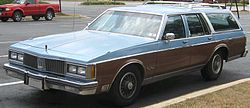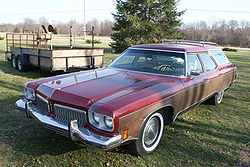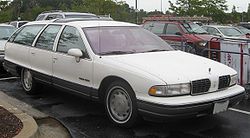- Oldsmobile Custom Cruiser
-
- For the Oldsmobile Custom Cruiser 90, 96 & 98 models of 1941-1947, see Oldsmobile 98.
Oldsmobile Custom Cruiser 
Manufacturer General Motors Production 1971–1992 Predecessor Oldsmobile 88 Fiesta Class Full-size Body style 4-door station wagon Layout FR layout The Oldsmobile Custom Cruiser is large rear-wheel drive station wagon which was produced by Oldsmobile from 1971 to 1992. The Custom Cruiser used the same platform as the Buick, Chevrolet and Pontiac full-size wagons. It was the first full-size Oldsmobile station wagon since 1964.
Oldsmobile had previously used the Customer Cruiser name on the Customer Cruiser 90, 96 & 98 models of 1941-1947.
Contents
First generation (1971–1976)
First generation 
Model years 1971–1976 Assembly Dearborn, Michigan, USA Platform C-body Engine 400 cu in (6.6 L) Pontiac V8
455 cu in (7.5 L) Rocket V8Transmission 3-speed TH-400, automatic Wheelbase 127.0 in (3,226 mm) Length 1971: 225.3 in (5,723 mm)
1972: 227.0 in (5,766 mm)
1973: 228.3 in (5,799 mm)
1974–75: 231.2 in (5,872 mm)
1976: 231.0 in (5,867 mm)Width 1971–75: 79.5 in (2,019 mm)
1976: 80.0 in (2,032 mm)Height 1971–75: 57.2 in (1,453 mm)
1976: 57.1 in (1,450 mm)Curb weight 5,100–5,500 lb (2,300–2,500 kg) Related Buick Electra
Buick Estate
Oldsmobile 98
Pontiac Grand Safari
Chevrolet Caprice EstateDesigner Bill Mitchell The first generation Custom Cruiser first appeared in 1971 based on the C platform. The station wagon could seat up to 8 forward-facing people. Until 1976, the station wagons featured a 'Clamshell' design where the rear power-operated glass slid up into the roof as the tailgate (manually or with power assist), dropped below the load floor. The power tailgate, the first in station wagon history, ultimately supplanted the manual tailgate, which required marked effort to lift from storage. The Clamshell system — heavy, complex, expensive, & space consuming — remained un-adopted by any other manufacturer. Though reliable, subsequent generations reverted to the doorgate style for its full-size wagons as the rear-facing 3rd seats left no room for a tailgate to retract into the body. Oldsmobile's 455 in³ (7.4 L) V8 engine was standard, although Pontiac's 400 cu in (6.6 L) V8 was also offered in 1975.
Second generation (1977–1990)
Second generation 
Model years 1977–1990 Platform B-body Engine 307 in³ V8
350 in³ V8
350 in³ diesel V8
403 in³ V8Transmission 3-speed Turbo-Hydramatic automatic
4-speed Turbo-Hydramatic automaticWheelbase 115.9 in (2,944 mm) Length 220.3 in (5,596 mm) Width 79.8 in (2,027 mm) Height 58.5 in (1,486 mm) Related Buick Electra Estate
Buick Lesabre
Oldsmobile Eighty-Eight
Pontiac Safari
Chevrolet CapriceThe second generation Custom Cruiser appeared in 1977 based upon the B platform. The second generation was smaller and lighter than the previous generation, and still able to seat up to 8 people. The electrically operated tailgate was replaced by a conventional two-way tailgate.
The new 1977 Custom Cruisers came with a standard 350 in³ (5.7 L) V8. Oldsmobile's 403 in³ (6.6 L) V8 was optional through 1979. In 1978, the 350 in³ diesel V8 became available; it would remain an option through 1985, after which it was discontinued. 1980 saw the introduction of the 307 in³ V8, becoming standard equipment. The gasoline 350 would remain as an option through 1980, but was dropped thereafter.
The Custom Cruiser was slightly restyled in 1980 with a lower front fascia. The doors and window mechanisms were also redesigned to be lighter. On the sides, the woodgrained panels no longer followed the curves of the wheel wells, but were positioned higher on the body sides to give a straighter, sleeker look; however, not all Custom Cruisers were equipped with woodgrained panels. 1980 saw the last restyling of the second generation Custom Cruisers.
Minor mechanical changes were made between 1980 and 1990. The new E4ME electronic carburetor which used GM's CCC (Computer Command Control) system was introduced in 1980 for models sold in California. In 1981, all Custom Cruisers used the E4ME with the CCC system, although Canadian emission cars continued to use the mechanical M4ME carburetor until 1986. Also new in 1981 was GM's new Turbo Hydramatic 200-4R automatic transmission with overdrive. This transmission was equipped with a lock-up torque converter and a 0.67:1 overdrive ratio. With the new transmission, the Custom Cruiser could be equipped with a numerically higher rear axle ratio for better performance, while offering improved fuel economy with the overdrive range. 1985 saw major changes to the 5.0 L (307 CID) V8 engine's cylinder head design. Introduced were new "swirl port" heads, which improved driveability and low-end torque. These new heads also featured very small intake ports, which reduced the higher RPM power and performance significantly. Along with the new heads, roller lifters replaced flat lifters. The 1989 Custom Cruiser was the last edition to have front shoulder belts mounted in the B-pillars; 1990 introduced door-mounted "passive" shoulder belts.
The second generation continued on until 1990, having become a stand-alone model by that point—the 88 and 98, very similar to the Custom Cruiser until after 1984, were downsized in 1985 and 1986 and became entirely different cars. In 1990, the second generation's last year, a historic event occurred—the Oldsmobile 'Rocket' V8, having been a unique Olds-designed engine around in some form or other since the 1949 model year, was dropped. From then on, Oldsmobile never again had an engine unique to the division.
Third generation (1991–1992)
Third generation 
Model years 1991–1992 Assembly Arlington, Texas, USA Platform B-body Engine 5.0 L V8
5.7 L V8Transmission 4-speed Turbo-Hydramatic automatic Wheelbase 115.9 in (2,944 mm) Length 217.5 in (5,525 mm) Width 79.7 in (2,024 mm) Height 60.3 in (1,532 mm) Related Buick Roadmaster
Chevrolet Caprice
Chevrolet Impala SSThe Custom Cruiser was completely redesigned for 1991, and included a second-row sunroof as a nod to the Vista Cruiser. When it was introduced, it was the only front engine, rear drive vehicle, body on frame Oldsmobile offered at the time, as the Oldsmobile 88 and Oldsmobile 98 had been changed to front wheel drive, the 98 for 1985 and the 88 for 1986. The Olds 307 was replaced by a 5.0 L, (305 in³) Chevrolet V8 engine. This engine was equipped with throttle body fuel injection and was rated at 170 hp (127 kW) The new Chevrolet engine offered an increase in performance as well as improved fuel economy. Also new for 1991 the Turbo-Hydramatic 200-4R was replaced by the 700R4 (4L60).
Sales did improve over the 1990 model year, with some 7,663 Custom Cruisers sold for the 1991 model run. Sales slipped to just over 4,300 in 1992, however, and Oldsmobile discontinued production. The 1992 model year offered a 5.7 L (350 in³) Chevrolet V8. This engine was also equipped with throttle body fuel injection and was rated at 180 hp (134 kW), and 300 lb·ft (410 N·m) of torque compared to the standard 305's 170 hp (127 kW) and 255 lb·ft (346 N·m) of torque.
After the discontinuing of the Custom Cruiser's siblings, the Chevrolet Caprice and Buick Roadmaster in 1996, along with the Cadillac Fleetwood, the GM factory in Arlington, Texas was converted for use building the Chevrolet Tahoe, GMC Yukon, and later, the Cadillac Escalade.
Production figures
1971 Total: 13,981
- Two-seat (six-passenger): 4,049
- Three-seat (nine-passenger): 9,932
1972 Total: 24,994
- Two-seat: 6,907
- Three-seat: 18,087
1973 Total: 38,921
- Two-seat, plain body: 5,275
- Two-seat, woodgrained body: 7,142
- Three-seat, plain body: 7,341
- Three-seat, woodgrained body: 19,163
1974 Total: 15,916
- Two-seat, plain body: 1,481
- Two-seat, woodgrained body: 2,960
- Three-seat, plain body: 2,528
- Three-seat, woodgrained body: 8,947
1975 Total: 16,068
- Two-seat, plain body: 1,458
- Two-seat, woodgrained body: 2,837
- Three-seat, plain body: 2,315
- Three-seat, woodgrained body: 9,458
1976 Total: 22,316
- Two-seat, plain body: 2,572
- Two-seat, woodgrained body: 3,849
- Three-seat, plain body: 3,626
- Three-seat, woodgrained body: 12,269
1977 Total: 32,827
- No breakdown of the number of two- and three-seat models produced is given in Oldsmobile's production figures for the Custom Cruiser from 1977 on.
1978 Total: 34,491
1979 Total: 36,648
1980 Total: 17,067
1981 Total: 18,956
1982 Total: 19,367
1983 Total: 25,243
1984 Total: 34,061
1985 Total: 22,889
1986 Total: 21,073
1987 Total: 17,742
1988 Total: 11,114
1989 Total: 8,929
1990 Total: 3,890
1991 Total: 7,663
1992 Total: 4,347
Engines for United States models
Generation Years Engine Power Torque Induction I 1971 455 in³ Oldsmobile V8 185 hp (138 kW) 355 lb·ft (481 N·m) 2bbl carburetor 1971–1973 455 in³ Oldsmobile V8 225 hp (168 kW) 360 lb·ft (488 N·m) 4bbl carburetor 1972 455 in³ Oldsmobile V8 250 hp (186 kW) 370 lb·ft (502 N·m) 4bbl carburetor 1974 455 in³ Oldsmobile V8 210 hp (157 kW) 350 lb·ft (475 N·m) 4bbl carburetor 1974 455 in³ Oldsmobile V8 275 hp (205 kW) 395 lb·ft (536 N·m) 4bbl carburetor 1975 400 in³ Pontiac V8 190 hp (142 kW) 350 lb·ft (475 N·m) 4bbl carburetor 1975–1976 455 in³ Oldsmobile V8 190 hp (142 kW) 350 lb·ft (475 N·m) 4bbl carburetor II 1977–1978 350 in³ Oldsmobile V8 170 hp (127 kW) 275 lb·ft (373 N·m) 4bbl carburetor 1977–1978 403 in³ Oldsmobile V8 185 hp (138 kW) 320 lb·ft (434 N·m) 4bbl carburetor 1978–1979 350 in³ Oldsmobile Diesel V8 120 hp (89 kW) 220 lb·ft (298 N·m) Indirect Injection 1979–1980 350 in³ Oldsmobile V8 160 hp (119 kW) 270 lb·ft (366 N·m) 4bbl carburetor 1979 403 in³ Oldsmobile V8 175 hp (130 kW) 310 lb·ft (420 N·m) 4bbl carburetor 1980 307 in³ Oldsmobile V8 150 hp (112 kW) 245 lb·ft (332 N·m) 4bbl carburetor 1980–1985 350 in³ Oldsmobile Diesel V8 105 hp (78 kW) 205 lb·ft (278 N·m) Indirect Injection 1981–1984 307 in³ Oldsmobile V8 140 hp (104 kW) 240 lb·ft (325 N·m) 4bbl carburetor 1985–1990 307 in³ Oldsmobile V8 140 hp (104 kW) 255 lb·ft (346 N·m) 4bbl carburetor III 1991–1992 5.0 L/305 in³ Chevrolet Small-Block V8 170 hp (127 kW) 255 lb·ft (346 N·m) Throttle-body FI 1992 5.7 L/350 in³ Chevrolet Small-Block V8 180 hp (134 kW) 300 lb·ft (410 N·m) Throttle-body FI NOTE All engines, including 1971 are listed in SAE net brake horsepower.
References
- Flammang, James & Ron Kowalke (1999). The Standard Catalog of American Cars 1976–1999. Krause Publications. ISBN 0-87341-755-0.
- Gunnell, John, Editor (1987). The Standard Catalog of American Cars 1946–1975. Krause Publications. ISBN 0-87341-096-3.
- Gunnell, John (2003). The Standard Catalog of V-8 Engines 1906–2002. Krause Publications. ISBN 0-87349-446-6.
External links
Cars 40 • 53 • 66 • 88 • 98 • 442 • Achieva • Alero • Aurora • Curved Dash • Custom Cruiser • Cutlass • Cutlass Calais • Cutlass Ciera • Cutlass Cruiser • Cutlass Supreme • F-85 • Firenza • Intrigue • Jetstar I • Limited Touring • Omega • Series 60 • Series 70 • Oldsmobile Series 90 • Starfire • Toronado • Vista CruiserMinivans / SUVs Concepts and Prototypes F-88 (1954) • Golden Rocket (1956) • Aerotech I (1987) • Aerotech II (1989) • Tube Car (1989) • Aerotech III (1989) • Expression (1990) • Antares (1995) • Alero Alpha (1997) • Recon (1999) • Profile (2000) • O4 (2001)Oldsmobile road car timeline, Post WW2–1970s — next » Type 1940s 1950s 1960s 1970s 6 7 8 9 0 1 2 3 4 5 6 7 8 9 0 1 2 3 4 5 6 7 8 9 0 1 2 3 4 5 6 7 8 9 Subcompact Starfire Compact F-85 Omega Mid-size 66/68 F-85 F-85 Vista Cruiser Vista Cruiser Vista Cruiser Cutlass Cruiser 76/78 Cutlass Cutlass Cutlass Cutlass Full-size 88 88 88 88 88 88 88 88 98 98 98 98 98 98 98 98 98 Custom Cruiser Custom Cruiser Personal luxury Toronado Toronado Toronado « previous — Oldsmobile road car timeline, 1980s–2004 Type 1980s 1990s 2000s 0 1 2 3 4 5 6 7 8 9 0 1 2 3 4 5 6 7 8 9 0 1 2 3 4 Compact Starfire Firenza Omega Cutlass Calais Achieva Alero Mid-size Cutlass Cutlass Ciera Cutlass Cutlass Cruiser Cutlass Cruiser Cutlass Supreme Cutlass Supreme Intrigue Full-size Eighty-Eight Eighty-Eight Eighty-Eight Ninety-Eight Ninety-Eight Ninety-Eight Regency Custom Cruiser Custom Cruiser LSS Aurora Aurora Personal luxury Toronado Toronado Minivan Silhouette Silhouette SUV Bravada Bravada Bravada Categories:- Full-size vehicles
- Oldsmobile vehicles
- Rear wheel drive vehicles
- Station wagons
- 1970s automobiles
- 1980s automobiles
- 1990s automobiles
Wikimedia Foundation. 2010.
